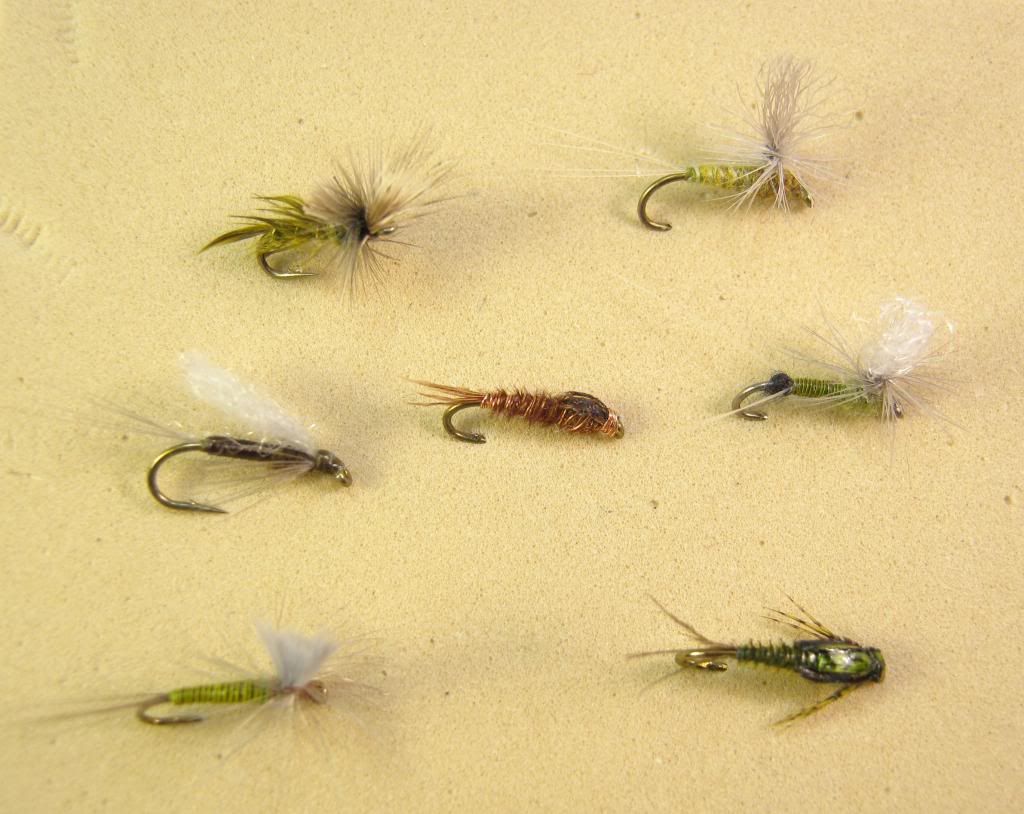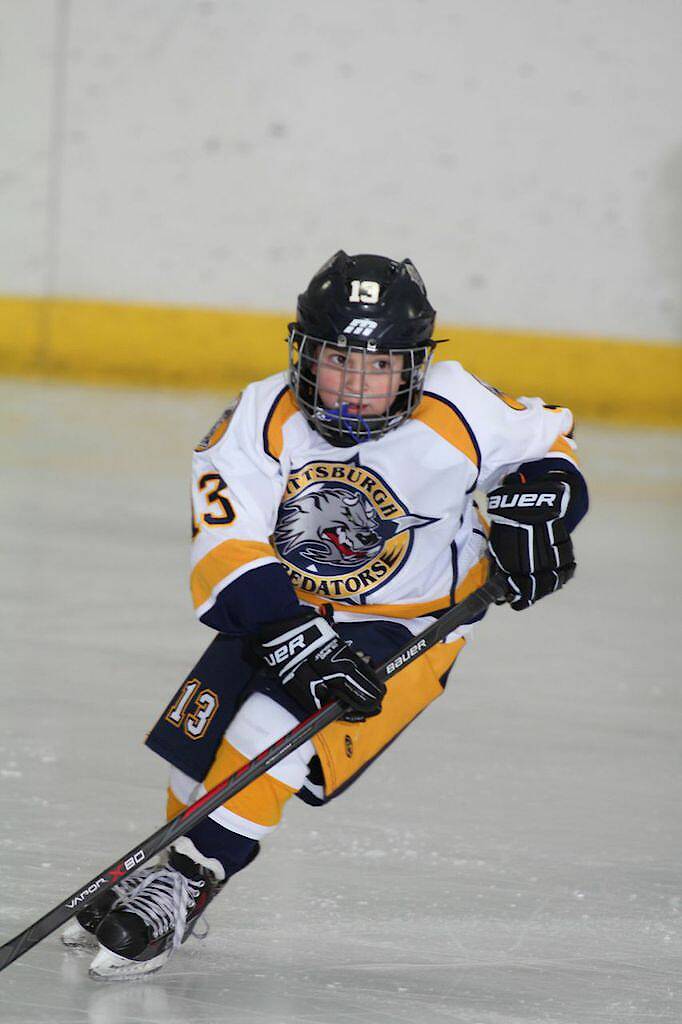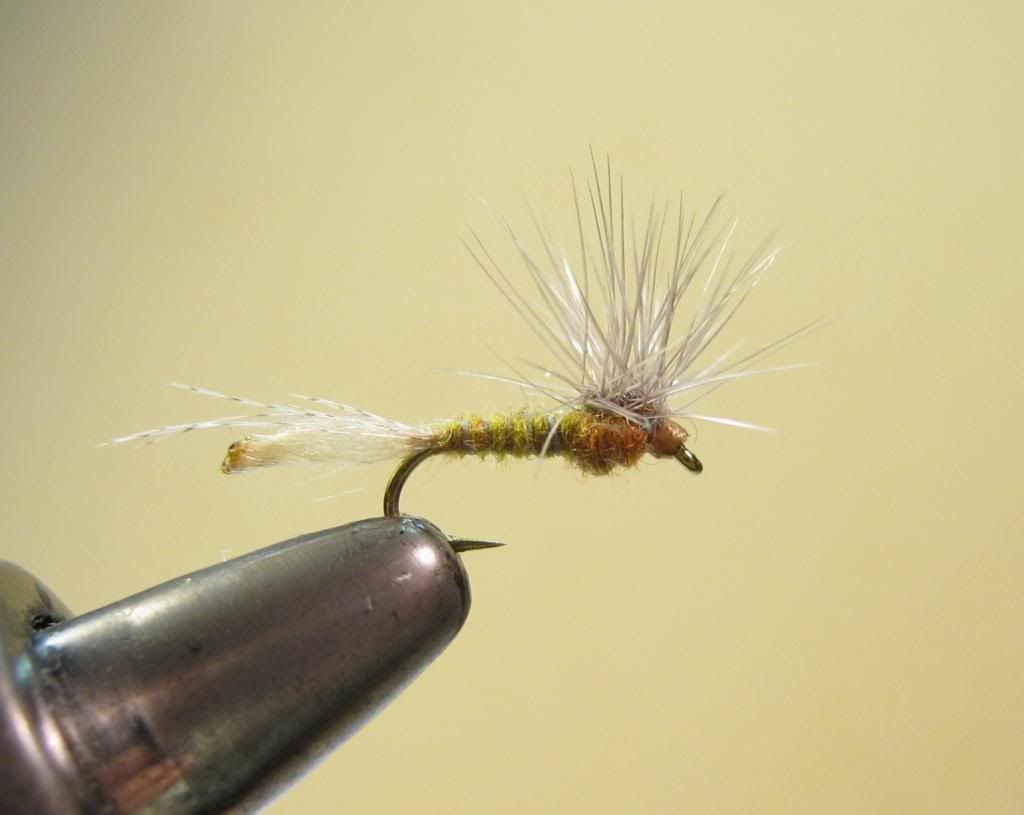
Salmonflies
Pteronarcys californica
The giant Salmonflies of the Western mountains are legendary for their proclivity to elicit consistent dry-fly action and ferocious strikes.
Featured on the forum

This specimen resembled several others of around the same size and perhaps the same species, which were pretty common in my February sample from the upper Yakima. Unfortunately, I misplaced the specimen before I could get it under a microscope for a definitive ID.

Troutnut is a project started in 2003 by salmonid ecologist Jason "Troutnut" Neuswanger to help anglers and
fly tyers unabashedly embrace the entomological side of the sport. Learn more about Troutnut or
support the project for an enhanced experience here.
Lastchance on Feb 19, 2013February 19th, 2013, 1:34 pm EST
I'm tying some Barr BWO Emergers for the first PA hatch, which I believe I'll tie on a size 14 or 16 scud hooks. My questions:
I can't remember what color I should make the emerging thorax. Is it a light olive?
The body, as far as I can remember from last year, is an olive brown?
I need to know tonight so I can get my materials ready for a tying session tomorrow at a friend's house.
Thanks All,
Bruce
I can't remember what color I should make the emerging thorax. Is it a light olive?
The body, as far as I can remember from last year, is an olive brown?
I need to know tonight so I can get my materials ready for a tying session tomorrow at a friend's house.
Thanks All,
Bruce
Martinlf on Feb 19, 2013February 19th, 2013, 2:30 pm EST
Bruce, although I'm often a bit nutty about color (and sometimes more than a bit), experience suggests it's not critical as my efforts might indicate, as long as you're in the ball park. One year I was having a lot of trouble with a pod of Spring Creek fish, and after throwing everything else in the box at them I pulled out a half and half emerger with cut wings. They ate it like candy. So I tied more, careful to exactly replicate the biot abdomens, which were dark brown with a little streak of mahogony brown in the center, and the thorax, which was Caucci spectrumized dubbing. But after a while and looking at photos of the naturals, I switched to olive abdomens, dying them a bit darker than the out of the store shade. They worked just as well. Then I found another pattern I liked, a fly tied with an all olive Unithread body, CDC shuck, and a clump of CDC for a short wedge wing. It worked very well too, but one year I messed up and tied them with the olive dun Unithread. And they worked just as well. In a few situations exact shades may make some difference. But most of the time, IMHO, it's presentation, presentation, presentation.
I do like having several different patterns, though, as I think the fish sometimes get used to seeing the same thing, and if you show them something different, it can trigger a response. That's probably what happened with the first emergers I mentioned above.
So, I think you'll be fine with the colors you suggest. Or some variations, if you want to experiment.
I do like having several different patterns, though, as I think the fish sometimes get used to seeing the same thing, and if you show them something different, it can trigger a response. That's probably what happened with the first emergers I mentioned above.
So, I think you'll be fine with the colors you suggest. Or some variations, if you want to experiment.
"He spread them a yard and a half. 'And every one that got away is this big.'"
--Fred Chappell
--Fred Chappell
Crepuscular on Feb 19, 2013February 19th, 2013, 2:52 pm EST
Lastchance on Feb 19, 2013February 19th, 2013, 3:38 pm EST
Thanks, guys. I have this written down, but I can't find my log book.
Bruce
Bruce
Gutcutter on Feb 19, 2013February 19th, 2013, 5:00 pm EST
Don't worry, Bruce. I'll have plenty.
The Spring Creek bugs have an almost green-olive abdomen and thorax when they first emerge. Quite bright, actually. They darken quickly and turn a brownish-oliveish like Eric said.
And, use 16&18 scud hooks and 18&20 standard hooks
Can't wait
The Spring Creek bugs have an almost green-olive abdomen and thorax when they first emerge. Quite bright, actually. They darken quickly and turn a brownish-oliveish like Eric said.
And, use 16&18 scud hooks and 18&20 standard hooks
Can't wait
All men who fish may in turn be divided into two parts: those who fish for trout and those who don't. Trout fishermen are a race apart: they are a dedicated crew- indolent, improvident, and quietly mad.
-Robert Traver, Trout Madness
-Robert Traver, Trout Madness
Entoman on Feb 19, 2013February 19th, 2013, 5:55 pm EST
The Spring Creek bugs have an almost green-olive abdomen and thorax when they first emerge. Quite bright, actually.
Quite right, Tony. We have tricaudatus out here as well and it's one of my favorite hatches. We get them in 16's & 18's in the Spring and again in the Fall in 14's & 16's. They look identical to the photo Eric took once they've been around awhile, but fresh they are more green and the thorax is a reddish amber. Like Louis said, I don't know that the exact color match is all that important, but I have found that the drab dark olive that's often used isn't nearly as effective.
There are certain patterns that I always seem to fall back on though there also always seem to be a few experiments in my boxes (I fooled around with CDC for a few years). Personally, I haven't found the vertical emergers as effective for this hatch, so I don't bother with them anymore, preferring my Ripe Nymph for this stage - at least where I've fished.:) Ditto spent spinners. I don't know if this is much help for the water you guys fish, but FWIW, here they are:
Baetis tricaudatus selection: (clockwise from upper right) Hi-Vis Paradun #16, Gravid ParaQuill #18, Ripe Baetid Nymph #16 (unweighted), Paraquill #16, Diving Egg Layer #16, Quigley Cripple (Baetis) #18. Oh, and a traditional Sawyer PT #18 for before the hatch. In spite of all the years trying, I can't improve on this one!:)

"It's not that I find fishing so important, it's just that I find all other endeavors of Man equally unimportant... And not nearly as much fun!" Robert Traver, Anatomy of a Fisherman
Entoman on Feb 19, 2013February 19th, 2013, 11:56 pm EST
"It's not that I find fishing so important, it's just that I find all other endeavors of Man equally unimportant... And not nearly as much fun!" Robert Traver, Anatomy of a Fisherman
Feathers5
Posts: 287
Posts: 287
Feathers5 on Feb 20, 2013February 20th, 2013, 3:05 am EST
Don't worry, Bruce. I'll have plenty.
The Spring Creek bugs have an almost green-olive abdomen and thorax when they first emerge. Quite bright, actually. They darken quickly and turn a brownish-oliveish like Eric said.
And, use 16&18 scud hooks and 18&20 standard hooks
Can't wait
Me, too. You mean the TMC 2488s or similar, Antonio?
Bruce
Feathers5
Posts: 287
Posts: 287
Feathers5 on Feb 20, 2013February 20th, 2013, 3:09 am EST
This just kills me. I have all of this written down. Antonio is my dry fly expert and I have copius notes that I can't find. The book is in my apartment. I'm glad I can rely on the expertise on this site.
Thanks Again,
Bruce
Thanks Again,
Bruce
Crepuscular on Feb 20, 2013February 20th, 2013, 3:42 am EST
Hey Bruce I'm sorry i didn't read your post as well as I should have. As both Kurt and Tony pointed out when those Spring Creek olives first pop they are pretty bight green.
Eric

Depending upon the type of water I'm fishing, I might trim the bottom hackle off the dun in the first picture if i'm fishing flat water.


Eric

Depending upon the type of water I'm fishing, I might trim the bottom hackle off the dun in the first picture if i'm fishing flat water.


Crepuscular on Feb 20, 2013February 20th, 2013, 3:48 am EST
Nice fly Kurt!
Wbranch on Feb 20, 2013February 20th, 2013, 4:00 am EST
Eric did you burn/melt the ends of the shuck and if so what is the purpose of doing this?
Catskill fly fisher for fifty-five years.
Crepuscular on Feb 20, 2013February 20th, 2013, 4:13 am EST
Yes I did, just to give it shape. It's difficult on such a little fly, this one is a #22 or #24 but I put it up as an example. If you notice Kurt did the same thing in his pattern The"Shuck Stuck Hackle Stacker (Baetid) #18"
Feathers5
Posts: 287
Posts: 287
Feathers5 on Feb 20, 2013February 20th, 2013, 5:09 am EST
Hey Bruce I'm sorry i didn't read your post as well as I should have. As both Kurt and Tony pointed out when those Spring Creek olives first pop they are pretty bight green.
Eric
Depending upon the type of water I'm fishing, I might trim the bottom hackle off the dun in the first picture if i'm fishing flat water.
Nice, Eric. So, what color is the abdomen and thorax? I can't see it well enough on my computer.
Bruce
Crepuscular on Feb 20, 2013February 20th, 2013, 6:10 am EST
Nice, Eric. So, what color is the abdomen and thorax? I can't see it well enough on my computer.
Bruce
Which one are you asking about? I guess it doesn't really matter which one. I go pretty straight forward light olive for both on the emerger and a little darker for the dun both abdomen and thorax, adding a little reddish brown to the former. Kurt's fly is pretty nice!
It probably doesn't matter that much though, I think silhouette and presentation is probably more important but the little buggers are pretty bright olive when they pop so maybe it does make more of a difference then.
Entoman on Feb 20, 2013February 20th, 2013, 9:51 am EST
Thanks, Eric. It's interesting to see how different anglers from different regions approach the same problem. Though we are a continent apart, spring creeks are spring creeks, trout are trout, and the same bug is the same bug. I didn't fully realize how "same" the critters were until you posted your photo! Sure points out why the taxonomy needed to be reworked synonymizing them.
Anyway, my favorite water to fish this hatch is definitely Fall River. The reason is due both to its blessing as well as its curse that allows me to fish with four rods. This is a real boon allowing me to hit the wave sync of the various stages. You really can't do it any other way as efficiently 'cause you're changing flies too much.:)
BTW - the reason I gave up on CDC is durability. Not its fish attracting abilities, that's for sure. I just didn't find it all that superior to some other materials (depending on purpose) to justify the continued fussing required. Hopefully your experiments with snowshoe will prove to be just as effective, at least in the larger sizes.
Anyway, my favorite water to fish this hatch is definitely Fall River. The reason is due both to its blessing as well as its curse that allows me to fish with four rods. This is a real boon allowing me to hit the wave sync of the various stages. You really can't do it any other way as efficiently 'cause you're changing flies too much.:)
BTW - the reason I gave up on CDC is durability. Not its fish attracting abilities, that's for sure. I just didn't find it all that superior to some other materials (depending on purpose) to justify the continued fussing required. Hopefully your experiments with snowshoe will prove to be just as effective, at least in the larger sizes.
"It's not that I find fishing so important, it's just that I find all other endeavors of Man equally unimportant... And not nearly as much fun!" Robert Traver, Anatomy of a Fisherman
Lastchance on Feb 20, 2013February 20th, 2013, 12:00 pm EST
I've been using snowshoe and it works great. It holds up better and is more visible.
Bruce
Bruce
Entoman on Feb 20, 2013February 20th, 2013, 2:54 pm EST
Eric did you burn/melt the ends of the shuck and if so what is the purpose of doing this?
Matt,
Expanding a little on Eric's explanation, the reason is silhouette. If you look at the fly from underneath, the standard square-cut z-lon shuck looks like a shaving brush. The burnt ones taper and look more like the natural shuck, especially with an overlay of two lengths of flank barbules to simulate tails and legs as well as adding a little speckling. I also use this technique for my caddis emergers though they are a little stouter and only overlaid with leg length barbules.

Eric,
I've found that the Aunt Lydia type antron yarn (the kind used for LaFontaine's pupae) works best for small flies. It melts nicer into a single glob ( Z-lon is a bit trickier in this regard) and its finer texture is more realistic. You already know this but for the benefit of others, remember to take about half of what you think you need. For tricaudatus shucks I comb out a ply of the gray, olive and tan together to blend them and then strip out a portion for husk manufacture, sized depending on fly size. Since you have to take the time to comb it out anyway, the blended colors aren't more work and is a nice touch. Cull out the shorts, roll between thumb and finger to form a tight cylinder and then trim the end to be melted even. It should be held maybe a quarter of an inch out from your fingers to keep it tight as you bring the flame near. I tie these by the gross and have found that finger warmth is as good an indicator as sight that it's done right. My fingers must have been a little numb with the one tied on that tricaudatus number as it's much browner than it should be.:) It should look more like the one above. Anyway, as soon it's melted roll it between the fingers to taper and thin the glob. Repeat the procedure with the other end. The finished product is about an inch long or so. It's a major time saver to make them all at once and store them in plastic hook bags. Besides that, they are much more consistent.
"It's not that I find fishing so important, it's just that I find all other endeavors of Man equally unimportant... And not nearly as much fun!" Robert Traver, Anatomy of a Fisherman
Crepuscular on Feb 20, 2013February 20th, 2013, 4:47 pm EST
Thanks Kurt.
Entoman on Feb 20, 2013February 20th, 2013, 5:01 pm EST
Ha! That's the fun of it! I hesitate to show some of the wild stuff I've come up with over the years! :) Needs a name... How about Caesarean Paratilt? :)
If you can figure a way to better taper the dun abdomen while still using foam for flotation. Hmmm...
On a serious note - There have been a lot of over-sized designs having a nymph on the back and a dun on the front that have come down the pike over the years. None of them work worth a damn in my experience. My theory is because the nymph portion that's supposed to imitate the husk is too rigid, dense and opaque.
BTW - I edited my previous post to better explain the full manufacturing process. Makes tying the stuck shucks faster than tying a traditional Catskill - and very consistent.
If you can figure a way to better taper the dun abdomen while still using foam for flotation. Hmmm...
On a serious note - There have been a lot of over-sized designs having a nymph on the back and a dun on the front that have come down the pike over the years. None of them work worth a damn in my experience. My theory is because the nymph portion that's supposed to imitate the husk is too rigid, dense and opaque.
BTW - I edited my previous post to better explain the full manufacturing process. Makes tying the stuck shucks faster than tying a traditional Catskill - and very consistent.
"It's not that I find fishing so important, it's just that I find all other endeavors of Man equally unimportant... And not nearly as much fun!" Robert Traver, Anatomy of a Fisherman
Quick Reply
Related Discussions
Topic
Replies
Last Reply
1
Sep 21, 2008
by GONZO
by GONZO
8
Jun 16, 2013
by PaulRoberts
by PaulRoberts







